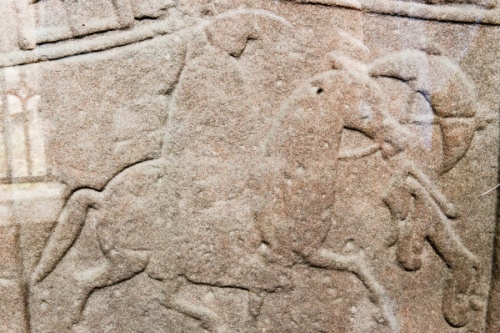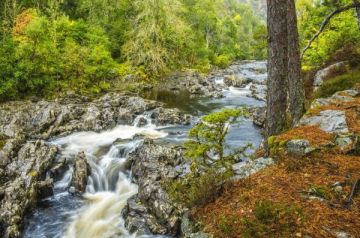
Pictish carved stones date from 2 broad eras. The earliest stones, dating to around 600 AD, are carved with traditional Pictish symbols including V-rods, Z-rods, crescents, combs, serpents, arrows, and mirrors. The second phase of carving began about AD 700 and shows the gradual transition of the ancient Pictish society to Christianity.
This later phase shows a dominant cross, with traditional symbols arranged around it. Often the cross will occupy one face of a stone slab, while scenes of everyday activities, such as hunting, will occupy the rear face of the stone.
The Dunfallandy Stone dates to the second phase of Pictish carved stones. One face of the red sandstone slab is dominated by a large cross, elaborately carved and surrounded by panels depicting human and fantastic animal figures. On the reverse of the stone a pair of sea monsters hold a human head. This scene may represent the Biblical tale of Jonah and the whale.

There are 3 further figures, one mounted, and 2 seated. Over the seated figures is a Pictish beast, a double-disc, a crescent, and V-rod. Another crescent and V-rod are carved in front of the horseman, and below this figure is a hammer, tongs, and an anvil. Were these tools an indication of the human's occupations, or a personal attribute?
Though so much of Pictish art remains a mystery and defies any exact interpretation, what isn't in doubt is the quality of the carving. It is simply superb, and the ornate design is very easy to make out.
One possible drawback is that the stone stands within a protective shed, shielded from the weather by plexiglass panels. If it is sunny, the plexiglass can have rather unwelcome reflections, which do obscure some of the carving detail. But don't let that put you off; the Dunfallandy Stone is one of the most impressive and best-preserved Pictish cross slabs I've seen, and is well worth a visit to see.

Visiting
The stone is signposted of Bridge Road, just where it runs into Foss Road, on the south bank of the River Tay. A minor road leads east and south, passes under the A9, and ends up at Mains of Dunfallandy. There is a farm gate, with a wide area for parking just inside the gate.
From there simply follow the drive uphill and you will see a burial ground on a rise above you. There is a steep set of steps up to the burial ground, and the Stone is within a protective shelter beside the burial site, under the overhanging branches of a tree.






 We've 'tagged' this attraction information to help you find related historic attractions and learn more about major time periods mentioned.
We've 'tagged' this attraction information to help you find related historic attractions and learn more about major time periods mentioned.




